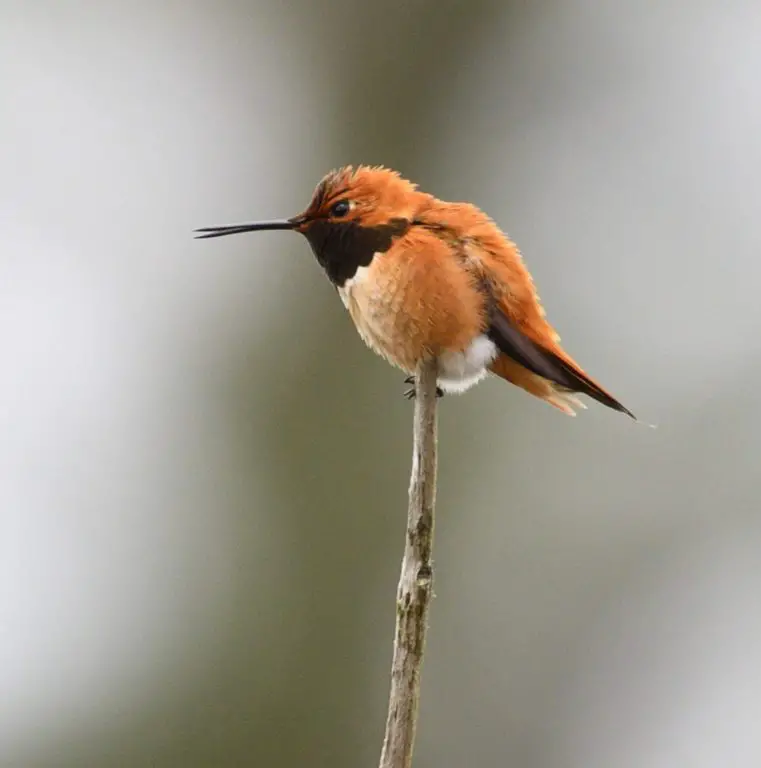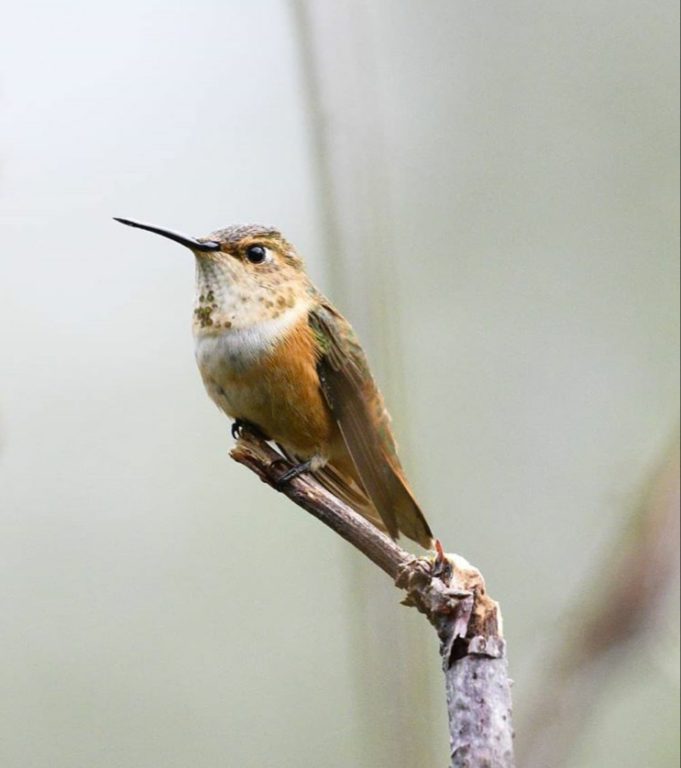This post contains affiliate links.
Washington, known as The Evergreen State, is located in the Pacific Northwest near British Columbia and Canada and is home to four species of hummingbirds with one out of the four being a native hummingbird species staying year-round.
Hummingbirds are known to exist within certain established ranges, either as year-round natives or as part of a migratory cycle.
What types of hummingbirds are found in Washington?
- There are 4 species of hummingbirds found in Washington.
- Year-round natives: Anna’s.
- Seasonal: Rufous, Black-chinned, Calliope.
- Rare: none
- Anna’s hummingbirds are the only species that stay 365 days out of the year in Washington while the Rufous, Black-chinned, and Calliope hummingbirds are seasonal summer migrants.
According to the United States Department of Agriculture, Rufous hummingbirds are the most common to be seen even though Anna’s hummingbirds are the only species that live in Washington year-round.
Categories of Hummingbirds:
Year-round/Native Hummingbirds
These hummingbird classifications are defined as hummingbirds residing in a group in Washington 365 days a year and do not migrate.
- Anna’s
Seasonal Hummingbirds
These hummingbirds are in Washington temporarily as part of their migratory pattern. Some of each of these species spend the entire spring, summer and fall in Washington while others of this migratory group may travel to more northern states during the summer.
- Rufous
- Black-chinned
- Calliope
Rare/Vagrant Hummingbirds
These hummingbird classifications are defined as hummingbirds residing in a group outside of their normal geographic range. Not only do these species of hummingbirds have a wide variety of specific geographic ranges, they are also known to sometimes interbreed with each other, creating hybrids.
There are zero rare/vagrant hummingbirds in Washington.
Read on to find out more about each of these hummingbird species as well as where and when they can be found in Washington.
Year-round/Native Hummingbirds
ANNA’S HUMMINGBIRD – (Calypte anna)
Conservation Status: Least concerned
Kingdom: Animalia
Phylum: Chordata
Class: Aves
Order: Apodiformes
Family: Trochilidae
Genus: Calypte
Species: C. anna
Anna’s hummingbirds are named after Anna Massena, Duchess of Rivoli. According to the U.S Fish and Wildlife Services of Willapa National Wildlife Refuge, Anna’s hummingbirds are the only hummingbird to stay year-round on the Pacific Coast in Washington. They are commonly seen in the western area of Puget Sound.
Abundant activity of Anna’s hummingbirds are seen in the Puget Trough ecoregion.
According to Landscope.org, the Puget Trough ecoregion runs the length of Washington, encompassing areas up to 1,000 feet elevation between the Cascade Mountains on the east and the Olympic Mountains and Willapa Hills on the west, with climates of high rainfall. The Puget Trough ecoregion makes up 8 percent of Washington State.
Male Anna’s hummingbirds are the only hummingbird species in North America with a red crown. They are identified as mostly green, gray, and magenta in color. The males have a flashier, more colorful iridescent magenta gorget and crown. Their size ranges from 3.5 inches to 4.3 inches in length.

Photo by: jace_the_bird_nerd
Taken: Long Beach, Washington

Photo by: jace_the_bird_nerd
Taken: Seaview, Washington

Photo by: jace_the_bird_nerd
Taken: Seaview, Washington
Female Anna’s hummingbirds are overall not as colorful as the males and are a more pale green. Females tend to have a pale white line over each eye that makes them distinctive.

Photo by: jace_the_bird_nerd
Taken: Washington

Photo by: jace_the_bird_nerd
Taken: Yacolt, Washington
Anna’s hummingbirds live in a chaparral habitat or Mediterranean climate with moderate wet winters and hot dry summers. Their habitat has expanded to Washington’s local residential gardens, parks, and coastal valleys. Which in turn provides access to an abundant food supply of nectar producing flowering plants and hummingbird feeders all year-round.
In 1976, the first recorded breeding of Anna’s hummingbirds was documented in Tacoma, Washington in Pierce County. Currently, they are recorded as breeding in the Puget Sound area between Edmonds (Snohomish County) and Tacoma (Pierce County). To get an idea of the distance between Tacoma and Puget Sound, the drive is over an hour.
Unlike many northern temperate hummingbirds, male Anna’s hummingbirds sing during courtship (though the song is so high-pitched and squeaky, it’s hard to call it singing).
Female Anna’s hummingbirds raise their young with no help from the males. Anna’s hummingbirds are commonly found nesting in Northern California.
Anna’s hummingbirds hybridize, cross breeding readily with other hummingbird species much like the Black-chinned hummingbirds.
See pictures of male, female and juvenile Anna’s hummingbirds here…..
Hear sounds of Anna’s hummingbirds here…..
Seasonal Hummingbirds
RUFOUS HUMMINGBIRD – (Selasphorus rufus)
Conservation Status: Near threatened
Kingdom: Animalia
Phylum: Chordata
Class: Aves
Order: Apodiformes
Family: Trochilidae
Genus: Selasphorus
Species: S. rufous
The Rufous hummingbird acquires its name from the Latin word rubrum meaning “red” describing its reddish-brown coloring.
As a migratory bird, Rufous hummingbirds trek up along the Pacific Coast in the spring reaching as far north as Alaska between late February to early March. They journey along the Washington coast before venturing east towards the mainland.
They time their arrival perfectly to when the red flowering currant and salmonberry patches are in bloom.
Male Rufous hummingbirds display an iridescent orange-red gorget with rusty-colored flanks and tail. They have a white to beige underbelly and a black bill. Males can also have green plumage with specks of green color on their rustic looking backs or on the crown of their head along with chocolate brown dorsal feathers. They are 3.1 inches in length.

Photo by: jace_the_bird_nerd
Taken: Long Beach, Washington

Photo by: jace_the_bird_nerd
Taken: Willapa National Wildlife Refuge, WA
Note: A male Rufous gorget can appear chocolate brown in less direct lighting.
Juvenile male Rufous hummingbirds have a rustic look with small iridescent orange specks of color on their throats.

Photo by: jace_the_bird_nerd
Taken: Washington
Female Rufous hummingbirds are green and white with some iridescent orange feathers on their throat. Their tail is dark with white tips and an orange-red base. Female Rufous hummingbirds are slightly larger than the males in anticipation of producing offspring.
Male Rufous hummingbirds breed in higher elevations and then will migrate south to winter in the Yucatan in Mexico. They will begin to leave their breeding grounds in June and July. The females and juvenile hummingbirds mostly migrate in August, but are documented beginning their migration south between July through September.
Female Rufous hummingbirds like to build their nests among huckleberry, alder, blackberries or conifer branches in the Puget Sound area of the Pacific Northwest.
Since the regions of Washington are notorious for their rainfall, determining a nesting location with shelter from precipitation and the cold are very important factors. Female hummingbirds who nest early chose to construct their nest in conifer trees. This protects their nest and offspring from the cold and rain.
Mothers that choose to nest later in the summer months when it is warmer prefer high deciduous trees that will protect them from overheating in the sun. They are known to re-use their nest or same location every year.
Rufous hummingbirds are highly territorial and are aggressive towards other hummingbirds and animals. They have been known to even attack squirrels and chipmunks that come too close to their nest. They can outmaneuver all other hummingbirds in the air, making them extremely competitive at feeders.
Rufous hummingbirds make the longest migrations of any bird in the world. They travel making a clockwise circuit of western America every year that is approximately 3,900 miles.
They have one of the northernmost breeding ranges of any hummingbird in the world, nesting as far north as Alaska. Rufous hummingbirds are polygamous and will mate with several partners in a season.
Rufous hummingbirds have excellent memories and have been known to investigate the location of an old hummingbird feeder years after the feeder has been removed.
Due to habitat loss in the Pacific Northwest, Rufous hummingbirds were listed at “near threatened” status by the IUCN red list of threatened species in 2018.
See pictures of male, female and juvenile Rufous hummingbirds here…..
Hear sounds of Rufous hummingbirds here…..
BLACK-CHINNED HUMMINGBIRD – (Archilochus alexandri)
Conservation Status: Least concerned
Kingdom: Animalia
Phylum: Chordata
Class: Aves
Order: Apodiformes
Family: Trochilidae
Genus: Archilochus
Species: A. alexandri
Black-chinned hummingbird’s scientific name is in commemoration of Dr. Alexandre, a French doctor who was the first to discover the species in Mexico. They are more common and have a higher population in northeastern Washington near the city of Spokane and Turnbull National Wildlife Refuge, close to the Idaho border.
Male Black-chinned hummingbirds are identified by their royal purple gorget, showing a small glimmer of color right near the neckline like a buttoned-up shirt. Since the male purple gorget or throat color is minimal, at times they can appear to look all black. They have metallic green on their backs and flanks with white on their underbelly. Their dark tail is forked and their bill is black. Their size is 3.25 inches long.

Photo by: hummingbirdsbysurprise
Female/juvenile Black-chinned hummingbirds have no gorget, but have a dark rounded tail with white tips and beige margins on the dorsal feathers that turn dark black as they mature. Their head and back reflect the dull metallic marbled colors of beige, greens, whites, yellow-green and dark browns, looking similar to the scales found on a snake.
Black-chinned hummingbirds are found in northeastern Washington in riparian wetland vegetation zones that have more precipitation.
The city of Washougal has documented Black-chinned hummingbirds breeding in the Silver Star Mountains during the months of May and June. Silver Star Mountain is an extinct volcano in the Gifford Pinchot National Forest positioned in the Cascade mountain range of Skamania County.
The males appear at the end of May and the females follow suit a few weeks later. These hummingbirds leave and are completely gone between July to the middle of August.
Black-chinned hummingbirds breed east of the Cascade mountain range and are the least common in Washington compared to the other three listed hummingbirds. Their breeding grounds and habitat are closely related to the Ruby-throated hummingbird.
Black-chinned hummingbirds are local migrants of Washington and are occasionally spotted drinking from feeders in Clark County.
They hybridize and readily crossbreed with other hummingbird species. Black-chinned hummingbirds can live up to 10 years, which is extremely long in comparison to other birds and animals of similar size.
Because of their small size, Black-chinned hummingbirds are at risk of being preyed-upon by larger insect-eating birds. Black-chinned hummingbirds are known to make their nests near larger more active bird nests, reducing the chance of predators around the nest by using a decoy strategy.
While typically a territorial species, if Black-chinned hummingbirds find themselves in an area with a large population of hummingbirds and food sources of plenty, their territorial behaviors will reduce and they will play nice and share.
Black-chinned hummingbirds have the smallest known genetic material of all living vertebrates or mammals.
See pictures of male, female and juvenile Black-chinned hummingbirds here…..
Hear sounds of Black-chinned hummingbirds here…..
CALLIOPE HUMMINGBIRD – (Selasphorus calliope)
Conservation Status: Least concerned
Kingdom: Animalia
Phylum: Chordata
Class: Aves
Order: Apodiformes
Family: Trochilidae
Genus: Selasphorus
Species: S. calliope
Calliope hummingbirds are named after a Greek mythological muse, who represented poetry and eloquence. Calliope means “beautiful voice” in ancient Greek. Calliope hummingbirds are seasonal migrants found in Washington between late April to mid-May. The rest of the time they winter in Mexico.
Male Calliope hummingbirds are easily identified by their iridescent purple crown and long striking spaced outline row of feathers that project down the sides of their throats. Their backs are, like many hummingbirds, metallic green. Their size measures 3 inches in length.

Photo by: sony_alpha_male

Photo by: sony_alpha_male
Female Calliope hummingbirds have gray-green crowns and buff-colored flanks which are the underbelly or wing of a bird. Females sport dark tails with white tips.

Photo by: sony_alpha_male
Their habitat consists of being in the Washington Ponderosa pine zone (coniferous trees). These trees have a life span of 300-600 years and have average heights between 100-150 feet.
Like many hummingbirds, Calliopes communicate not just by their song, but also by manipulating their feathers during flight to make different buzzing noises that act as a form of language and communication.
Calliope hummingbirds are the smallest long-distance migratory bird in the world. They tend to breed in the higher elevations of the Rocky Mountains along the north side of the Skagit River watershed near Newhalem in Whatcom County which is close to North Cascades National Park. This river’s headwater starts near British Columbia and the mouth ends at Puget Sound.
They are also seen at backyard feeders in Clark County, Washington near the Oregon border during migration, which is four and a half hours south of Newhalem.
Male Calliope hummingbirds establish a breeding territory and mate with every available female hummingbird that accepts his courtship.
When a female Calliope hummingbird builds a nest she is known to both nest on the top of pine cones and to steal building materials from the nests of other birds in order to construct her own. She will dismantle nests from previous seasons and recycle them in her new nest.
They are often attacked and chased by larger, more aggressive species of hummingbirds, such as Allen’s and Rufous hummingbirds which causes them to maintain a relatively low profile in comparison to other species.
Because Calliope hummingbirds have a more restricted wintering range than most hummingbirds, they are particularly vulnerable to habitat loss and natural disasters, such as climate change and wildfires.
See pictures of male, female and juvenile Calliope hummingbirds here…..
Hear sounds of Calliope hummingbirds here…..
Rare/Vagrant Hummingbirds
There are no rare/vagrant hummingbirds species found in Washington.
Happy Hummingbird Watching!

Taken: Willapa National Wildlife Refuge (Juvenile Rufous)
Plant: Rubus spectabilis – Salmonberry
Backyard Visitors participates in affiliate programs which compensate us for referring traffic.

